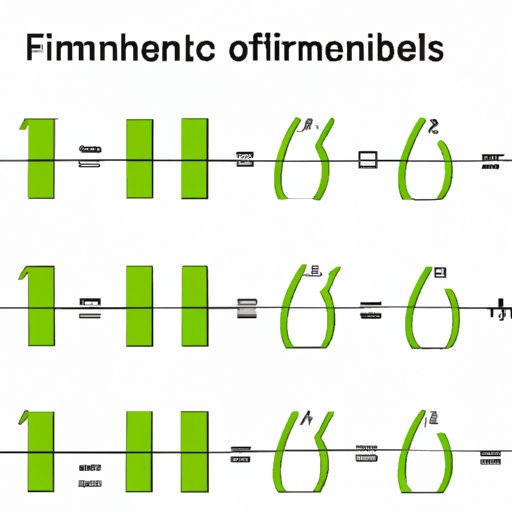
Introduction
A finite series is a sequence of numbers that has a finite number of terms. It is an important concept in mathematics and has practical applications in physics, engineering, and finance. Being able to calculate a finite series efficiently is essential for solving complex problems in these fields. This article provides a step-by-step guide, tips and tricks, examples, and common mistakes to avoid when calculating finite series.
A Step-by-Step Guide to Calculating a Finite Series
Before calculating a finite series, you need to understand the terms involved. A finite series consists of a sequence of terms that can be added up. It is represented by the summation notation ∑. The terms are denoted by a variable with a subscript. For example, if we have a finite series consisting of 5 terms, the terms would be a1, a2, a3, a4, and a5.
Using the summation notation, the finite series can be represented as:
Sn = ∑nk=1 ak
The above formula represents a summation of n terms starting from k=1 to k=n. The variable k represents the position of a term in the series. The variable n represents the number of terms in the series.
The steps to calculate a finite series are:
- Identify the number of terms in the series (n).
- Write down the explicit formula for the series (an) if given.
- Find the first term (a1) if given or use the explicit formula to determine it.
- Use the summation formula to calculate the value of the series.
Tips and Tricks for Simplifying the Calculation of a Finite Series
Calculating a finite series can be time-consuming and tedious. However, there are some tips and tricks you can use to simplify the process:
Look out for common patterns in finite series: Some finite series have patterns that can be easily identified and applied to simplify calculations. For example, in an arithmetic series, the difference between consecutive terms is constant. In a geometric series, the ratio of consecutive terms is constant.
Look for shortcuts to simplify calculation: In some cases, you can use common formulas and identities to simplify calculation. For example, the sum of the first n natural numbers is given by n(n+1)/2.
Simplify a complicated finite series by breaking it down into smaller parts: Sometimes, a finite series can be broken down into smaller parts that are easier to calculate. You can then add up the values of the smaller parts to obtain the value of the entire series.

Examples of Finite Series with Different Outcomes and How to Calculate Them
There are different types of finite series with different outcomes. Here are some examples:
Simple arithmetic series: An arithmetic series has a constant difference between consecutive terms. The explicit formula for an arithmetic series is an = a1 + (n-1)d, where d is the common difference. For example, the series 2+4+6+8+10 can be calculated as follows:
S5 = ∑5k=1 (2 + (k-1)2) = 30
Geometric series: A geometric series has a constant ratio between consecutive terms. The explicit formula for a geometric series is an = a1rn-1, where r is the common ratio. For example, the series 2+4+8+16+32 can be calculated as follows:
S5 = ∑5k=1 2(2)k-1 = 62
Harmonic series: A harmonic series has terms that are the reciprocals of natural numbers. For example, the series 1/1 + 1/2 + 1/3 + 1/4 + 1/5 can be calculated as follows:
S5 ≈ 2.283
Alternating series: An alternating series has terms that alternate in sign. The series can converge or diverge depending on the magnitude of the terms. For example, the series 1 – 2 + 3 – 4 + 5 can be calculated as follows:
S5 = ∑5k=1 (-1)k+1k = -3
Exponential series: An exponential series has exponential functions as terms. For example, the series ex + e2x + e3x can be calculated as follows:
S3 = ex (1 + ex + e2x)
Understanding the Significance of Finite Series and How to Calculate Them Efficiently
Finite series have practical applications in various fields. For example, they are used in physics to calculate the total distance traveled by a moving object, in finance to calculate the total value of a future investment, and in engineering to calculate the total power output of a machine. Being able to calculate finite series efficiently is essential for solving complex problems in these fields.
To maximize efficiency in calculating finite series, you need to understand the different types of finite series and their properties. This includes understanding the formulas and patterns associated with arithmetic, geometric, harmonic, and other types of series. You also need to be able to identify when a series can be broken down into smaller parts and when common formulas can be applied to simplify calculations.
Common Mistakes to Avoid While Calculating Finite Series
Here are some common mistakes to avoid when calculating finite series:
Confusing the terms or elements of a series: It is important to keep track of the terms and elements of a series. Confusing or mixing them up can lead to miscalculations.
Miscalculating or missing terms in a series: Missing or miscalculating even one term in a series can lead to significant errors in the final value of the series.
Using the wrong formula for a particular type of series: Different types of finite series have different formulas and properties. Using the wrong formula can lead to incorrect results.
Calculating Finite Series Using Different Mathematical Formulas and Techniques
There are different mathematical formulas and techniques that can be used to calculate finite series. Here are some examples:
Different formulas for calculating arithmetic, geometric, and other types of finite series: Each type of finite series has its own formula for calculating the sum. For example, an arithmetic series can be calculated using the formula Sn = n/2(a1 + an), where a1 is the first term, an is the nth term, and n is the number of terms.
Using integration to solve complicated series: Integrals can be used to solve some complicated series. For example, the series ∑∞n=1 n-2 can be solved using the integral ∫∞1 x-2 dx = 1.
Calculating series involving limits and functions: Some series involve limits or functions that can be evaluated using calculus. For example, the series ∑∞n=1 xn-1/n can be calculated using the natural logarithm function.
Advantages and Limitations to Using Different Methods to Calculate Finite Series
There are advantages and limitations to using different methods to calculate finite series. Some methods may be more accurate or efficient than others, depending on the type of series and the tools available. Factors that influence the choice of method for calculating a finite series include the complexity of the series, the accuracy required, and the available resources.
Conclusion
Calculating a finite series can be a challenging but rewarding task. It requires an understanding of the different types of series, their properties, and the formulas and techniques used to calculate them. By following the step-by-step guide, tips and tricks, and examples provided in this article, you can successfully calculate finite series and solve complex problems in various fields.




